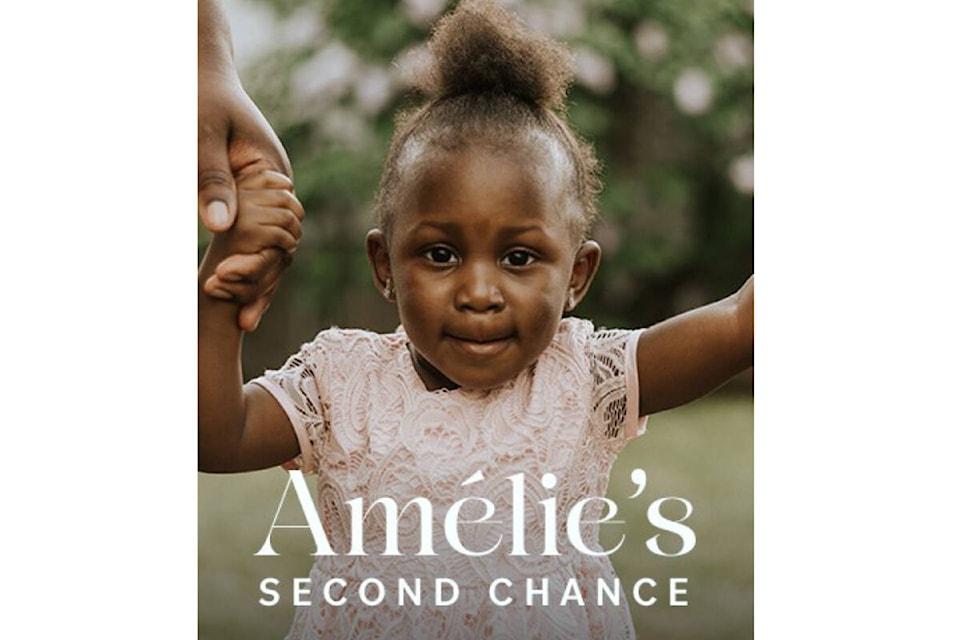“I never thought I would see my joyful daughter full of life go from jumping, playing with her siblings to limp and lifeless in the span of one day.”
Those words from Leslie Bangamba begin Amélie’s Second Chance, an emotional and gripping documentary about how the swallowing of a small battery nearly cost her 18-month-old daughter her life in April 2020.
The life-changing event started Leslie on an advocacy journey that continues to this day.
After Amélie collapsed on the afternoon of April 9, 2020 she was first taken to Red Deer’s hospital, where she vomited a huge amount of blood. An x-ray showed a small battery lodged in her airway. As Leslie and Amélie’s father, Astrel Adolphe, waited anxiously, their child was intubated and quickly transferred by ambulance to Edmonton’s Stollery Children’s Hospital.
The tiny girl went into cardiac arrest twice, went through open-heart surgery and was put on a heart-lung bypass machine and required huge blood infusions. She suffered a stroke and brain bleeding and repairs later had to be made to esophagus, trachea and key arteries before she could leave hospital 37 days later.
She almost died because once the coin-sized lithium battery she swallowed without anyone knowing came in contact with her saliva it triggered an immediate chemical reaction that then began its destructive work, possibly up to two days before there were signs of anything wrong.
Amélie had to undergo surgery as recently as last September but now is mostly recovered and as active as any other four-year-old and enjoys playing with her older brothers, 11 and eight years old.
Leslie Bangamba felt compelled to warn others about the dangers of the small batteries found in everything from watches, remotes, toys and other small electronic devices. She worked with major battery maker Duracell, which has made battery packaging more child proof and coated them with a foul-tasting chemical to deter children from putting them in their mouths.
A grateful Bangamba has also tried to thank all those who helped save her daughter’s life and those of so many other children. Her family raised $15,000 for Stollery Children’s Hospital through Amélie’s Annual Birthday Fundraisers.
The 34-minute documentary produced through TELUS STORYHIVE and its Black Screen Office also serves as a show of gratitude. A number of the health professionals who helped Amélie recount their experiences in the film.
The documentary is among the projects to premiere in TELUS STORYHIVE’s first Black Creators Edition in support of Black History Month.
The initiative linked a Black content creator with someone with a story to tell supported by $20,000 in funding.
Leslie Bangamba said when she began raising awareness about what happened to her daughter and the need for better battery safety she was grateful for the time given to her by the media and others. But the time she had to tell her story was usually measured in minutes and she had so much more she wanted to say.
“I always felt like I was hitting on the points on what happened but I could never fully elaborate on what it was truly like going through that,” she said in an interview on Tuesday, a day before her documentary will be available on TELUS Optik TV Channel 707 and on STORYHIVE’S YouTube channel.
When Bangamba’s proposal was accepted by TELUS STORYHIVE she admits to being extremely nervous. She had no experience filming a documentary or handling the myriad other behind-the-scenes details required to turn an idea into a digital film.
However, the STORYHIVE program is designed to help those like her. She was paired with an experienced documentary maker and program managers are always available to handle questions and offer advice.
“It’s really neat for someone to get their feet wet in the world of filmmaking. It was a huge learning curve. I like to say it was literally sink or swim. There was just a lot of information to process.
“In same breath, I’m sharing a story that’ so personal to me that you want to do your story justice. You want to make sure the message is conveyed the way you hope it is.
“It’s just really scary to put yourself out there.”
Opening in front of the camera and showing her vulnerability was difficult.
“There were a lot of moments were I thought, ‘What have I done?’ Am I actually sharing my trauma and reliving it willingly. What’s wrong with me?” she said with a laugh.
“It was uncomfortable but it needed to be done.”
Bangamba wants to do more documentaries.
“This is something I really would love to try again. I’ve always loved story telling because I truly believe there is more that brings us together than separates us.
“The best way to know that is by story telling. By listening to other people’s stories and sharing your own.”
“I definitely want to explore different avenues of story telling the documentary world. I just think there are so many stories that go untold.”
That the documentary will be come out at the start of Black History Month is important to her as well.
Black people have not often had the platform to share their stories about universal experiences that can affect us all, she said.
“My story is not just for Black people. It’s for everyone.”
